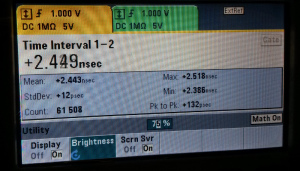Orienteering again after a long break - last event was in October 2014.
Easy course but lots of forbidden areas to avoid. Not too cold but quite windy.
Let's say you have a DSO-X 2000 or 3000 series oscilloscope and you're not super keen on paying about 300 euros for the brand-name DSOXLAN module to enable the Ethernet port it already essentially has on board? No worries, just build yourself this DIY DSOXLAN module! The most expensive part of this build is the 8 euro magjack Ethernet connector.
Sources: https://github.com/aewallin/DSOXLAN
In other news this blog has been updated to WordPress 4.1. Hope everything works OK.
I got a 4-channel 4 GS/s 350 MHz Agilent DSO-X 3034A scope on ebay!
So far I've just explored the Easter eggs built into the firmware 🙂
I made these two plate-nuts on the manual mill today. 3mm thick Titanium (ASTM B265 - grade 2) sheet from Titanium Service. The plate-nuts measure 12 x 5 x 3 mm with 9 mm center-to-center for the M2.5 threads. The M2.5 screws are also Titanium - since we don't want to use magnetic materials for these parts.
We got some White Rabbit Switches and I did an initial test of the pulse-per-second (PPS) output stability. In contrast to earlier measurements that showed 200ps or so of white phase noise, the PPS output on the WRS now seems a lot more stable. For various reasons the noise-floor (red data) of our 53230A time-interval-counter is at around 50e-12 @ 1s, and the WRS PPS output is at very much the same level of stability. Another 53230A counter shows about 13 ps standard-deviation for a cable-delay measurement - so I may redo these measurements with that counter. In any case a real evaluation of the short-term stability requires a DMTD measurement at 10 MHz.
Update: after the fix the counter seems OK again. 12 ps standard deviation (61k PPS-pulses, collected over 17 hours) on a cable-delay test:

A broken CH1 input trace seems to be a common problem on the Agilent/Keysight 53230A counter. This is the second unit with the same problem we have seen.
The fix is to bypass the broken trace with a wire directly from the center of the input-BNC to the next unpopulated SMD-pad.
I attended a VLBI-meeting at Groningen and had a chance to see the Dwingeloo radio telescope at JIVE.
The telescope is now run by amateurs and among other things they do moonbounce experiments.
Here's the beat-note, as seen on a spectrum analyzer, between a red laser at 445 THz (or 674 nm, if you prefer wavelengths instead of frequencies) and a femtosecond frequency comb. The frequency comb has evenly spaced (100 MHz in our case) 'teeth' at well-defined multiples of RF-frequencies that we can lock to a H-maser. This allows absolute frequency measurements of the optical frequency at 445 THz. Currently we are trying to improve the SNR of the beat-note so that a frequency-counter will give a stable output reading of the beat-note frequency. The video shows about 20 dB of SNR using 10 kHz RBW (if you are optmistic), but reliable counting requires around 25 dB SNR using a 100 kHz RBW.
This laser will be used as the 'clock-laser' in our ion-clock where it is used to drive a narrow clock-transition of a single laser cooled Sr+ ion. Earlier I blogged about measuring the thermal expansion of the optical cavity that is used to stabilize the laser.
Viikin vitonen 5k race today. +2C and a bit windy. 22:52 or 4:33/km. 1km splits: 4:26-4:30-4:31-4:39-4:37. Maybe slightly too fast in the beginning which made the 4th and 5th kilometre hard.
Here are some views from the area: